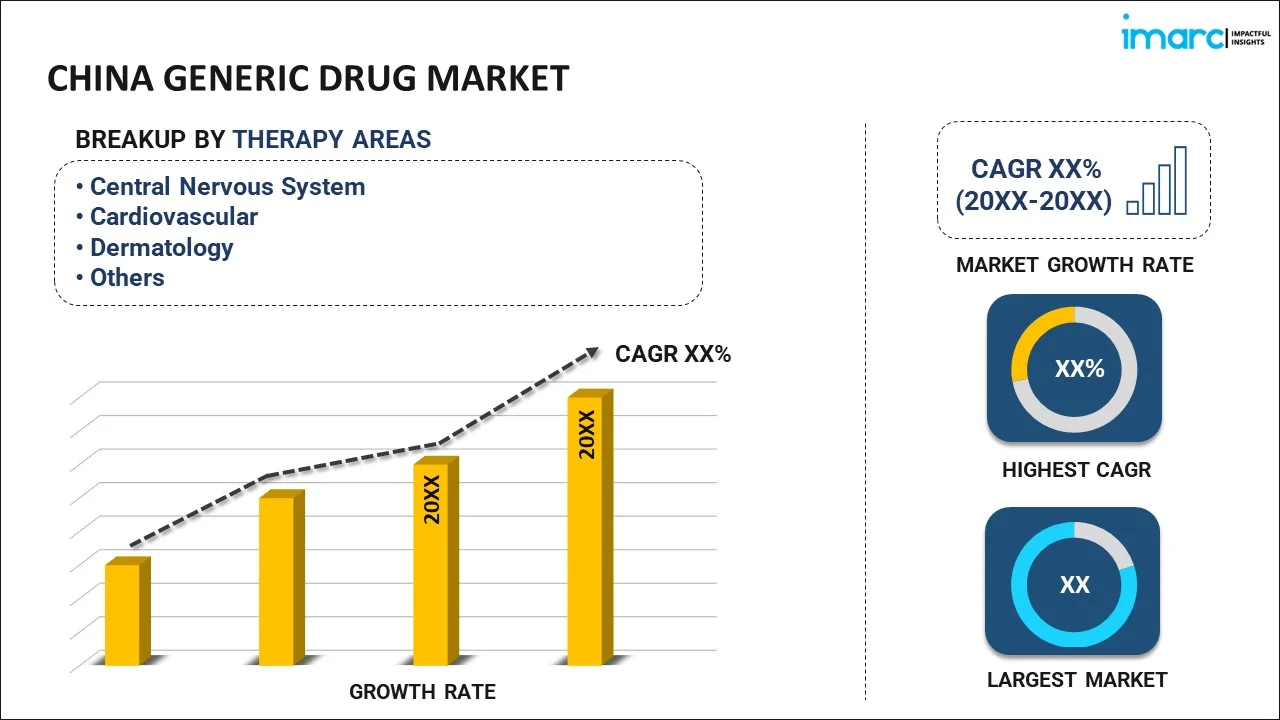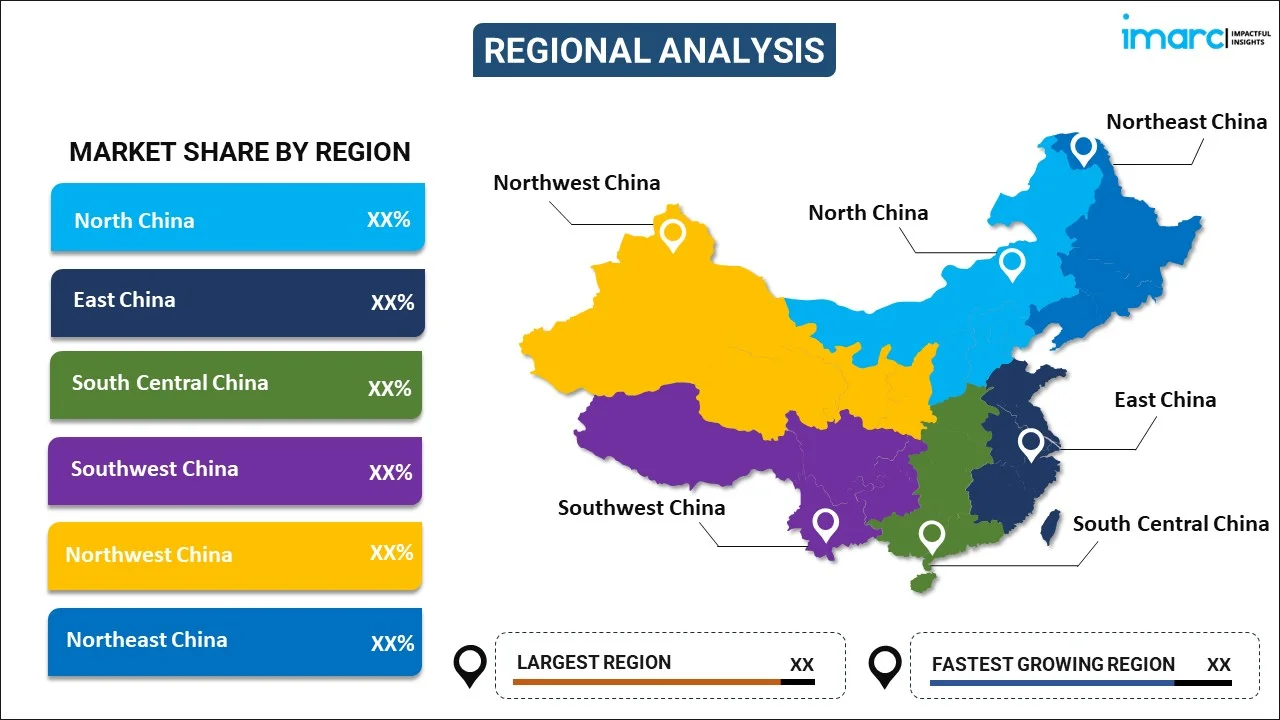
China Generic Drug Market Report by Therapy Area (Central Nervous System, Cardiovascular, Dermatology, Genitourinary/Hormonal, Respiratory, Rheumatology, Diabetes, Oncology, and Others), Drug Delivery (Oral, Injectables, Dermal/Topical, Inhalers), Distribution Channel (Retail Pharmacy, Hospital Pharmacy, Online Pharmacy), and Region 2024-2032
China Generic Drug Market Overview:
The China generic drug market is projected to exhibit a growth rate (CAGR) of 10.70% during 2024-2032. Various factors including patent expirations of brand-name drugs, cost-effectiveness, increasing healthcare needs, government support for affordable medication, and the rising prevalence of chronic diseases requiring long-term medication are aiding in market expansion.
|
Report Attribute
|
Key Statistics
|
|---|---|
|
Base Year
|
2023 |
|
Forecast Years
|
2024-2032
|
|
Historical Years
|
2018-2023
|
| Market Growth Rate (2024-2032) | 10.70% |
China Generic Drug Market Trends:
Expiration of patents on brand-name drugs:
As patents on these drugs expire, generic manufacturers can produce and market bioequivalent versions at a lower cost. This process, known as the "patent cliff," creates opportunities for generic drug manufacturers to capture market share from brand-name drugs. The availability of generic versions typically leads to substantial reductions in the price of medications, benefiting both consumers and healthcare providers. Furthermore, the Chinese government has been actively promoting the development and utilization of generic drugs to reduce healthcare costs and improve access to essential medications. Policies such as the centralized drug procurement program have been implemented to encourage the use of generics in public hospitals, leading to a more competitive market environment. Moreover, the China National Medical Products Administration (NMPA) has streamlined the approval process for generic drugs, ensuring they meet stringent standards equivalent to those of brand-name medications. Additionally, initiatives like the Quality Consistency Evaluation (QCE) aim to enhance the quality of domestically produced generic drugs, further boosting consumer confidence.
Cost-containment measures:
Cost-containment measures implemented by governments and healthcare organizations also significantly drive the generic drug market. With escalating healthcare costs, there is a growing emphasis on reducing expenditures while maintaining access to essential medications. Generic drugs, being significantly cheaper than their branded counterparts, present an attractive solution for managing healthcare budgets. China introduced the national bulk-buying program, where the government negotiates lower prices for medications through centralized procurement processes. This initiative has significantly reduced drug prices and increased the adoption of generics in hospitals and other healthcare facilities. Moreover, the Chinese government has enforced price caps on certain essential medications, making generics a more attractive option for both healthcare providers and patients. Apart from this, insurance companies and healthcare providers are also increasingly promoting the use of generics as a cost-effective alternative, further strengthening their adoption.
Increasing prevalence of chronic diseases:
The rising prevalence of chronic diseases significantly drives the generic drug market. Conditions like diabetes, hypertension, cardiovascular diseases (CVDs), and cancer necessitate long-term medication, creating a continuous demand for affordable treatments. For instance, in 2021, China had a total adult population of 1,079,960,800, with a 13% diabetes prevalence, amounting to approximately 140,869,600 cases. Generic drugs offer a cost-effective solution, essential for managing these chronic conditions and supporting healthcare systems. Additionally, advancements in medical research and diagnostics lead to earlier and more frequent diagnoses, expanding the patient base dependent on long-term medication. This growing need for sustained care ensures a steady demand for generic drugs, creating a positive outlook for market expansion.
China Generic Drug Market News:
- In October 2023, China introduced a new regulatory requirement mandating that Abbreviated New Drug Applications (ANDAs) for generic drugs without reference listed drugs must demonstrate clinical value. The National Medical Products Administration (NMPA) announced this modification in an effort to guarantee that generic medications are both clinically and chemically effective.
China Generic Drug Market Segmentation:
IMARC Group provides an analysis of the key trends in each segment of the market, along with forecasts at the country level for 2024-2032. Our report has categorized the market based on therapy area, drug delivery, and distribution channel.
Therapy Area Insights:

- Central Nervous System
- Cardiovascular
- Dermatology
- Genitourinary/Hormonal
- Respiratory
- Rheumatology
- Diabetes
- Oncology
- Others
The report has provided a detailed breakup and analysis of the market based on the therapy area. This includes central nervous system, cardiovascular, dermatology, genitourinary/hormonal, respiratory, rheumatology, diabetes, oncology, and others.
Drug Delivery Insights:
- Oral
- Injectables
- Dermal/Topical
- Inhalers
A detailed breakup and analysis of the market based on the drug delivery have also been provided in the report. This includes oral, injectables, dermal/topical, inhalers.
Distribution Channel Insights:
- Retail Pharmacy
- Hospital Pharmacy
- Online Pharmacy
The report has provided a detailed breakup and analysis of the market based on the distribution channel. This includes retail pharmacy, hospital pharmacy, and online pharmacy.
Regional Insights:

- North China
- East China
- South Central China
- Southwest China
- Northwest China
- Northeast China
The report has also provided a comprehensive analysis of all the major regional markets, which include North China, East China, South Central China, Southwest China, Northwest China, and Northeast China.
Competitive Landscape:
The market research report has also provided a comprehensive analysis of the competitive landscape. Competitive analysis such as market structure, key player positioning, top winning strategies, competitive dashboard, and company evaluation quadrant has been covered in the report. Also, detailed profiles of all major companies have been provided.
China Generic Drug Market Report Coverage:
| Report Features | Details |
|---|---|
| Base Year of the Analysis | 2023 |
| Historical Period | 2018-2023 |
| Forecast Period | 2024-2032 |
| Units | US$ Billion |
| Scope of the Report | Exploration of Historical Trends and Market Outlook, Industry Catalysts and Challenges, Segment-Wise Historical and Future Market Assessment:
|
| Therapy Areas Covered | Central Nervous System, Cardiovascular, Dermatology, Genitourinary/Hormonal, Respiratory, Rheumatology, Diabetes, Oncology, Others |
| Drug Deliveries Covered | Oral, Injectables, Dermal/Topical, Inhalers |
| Distribution Channels Covered | Retail Pharmacy, Hospital Pharmacy, Online Pharmacy |
| Regions Covered | North China, East China, South Central China, Southwest China, Northwest China, Northeast China |
| Customization Scope | 10% Free Customization |
| Post-Sale Analyst Support | 10-12 Weeks |
| Delivery Format | PDF and Excel through Email (We can also provide the editable version of the report in PPT/Word format on special request) |
Key Questions Answered in This Report:
- How has the China generic drug market performed so far and how will it perform in the coming years?
- What has been the impact of COVID-19 on the China generic drug market?
- What is the breakup of the China generic drug market on the basis of therapy area?
- What is the breakup of the China generic drug market on the basis of drug delivery?
- What is the breakup of the China generic drug market on the basis of distribution channel?
- What are the various stages in the value chain of the China generic drug market?
- What are the key driving factors and challenges in the China generic drug?
- What is the structure of the China generic drug market and who are the key players?
- What is the degree of competition in the China generic drug market?
Key Benefits for Stakeholders:
- IMARC’s industry report offers a comprehensive quantitative analysis of various market segments, historical and current market trends, market forecasts, and dynamics of the China generic drug market from 2018-2032.
- The research report provides the latest information on the market drivers, challenges, and opportunities in the China generic drug market.
- Porter's five forces analysis assist stakeholders in assessing the impact of new entrants, competitive rivalry, supplier power, buyer power, and the threat of substitution. It helps stakeholders to analyze the level of competition within the China generic drug industry and its attractiveness.
- Competitive landscape allows stakeholders to understand their competitive environment and provides an insight into the current positions of key players in the market.
Need more help?
- Speak to our experienced analysts for insights on the current market scenarios.
- Include additional segments and countries to customize the report as per your requirement.
- Gain an unparalleled competitive advantage in your domain by understanding how to utilize the report and positively impacting your operations and revenue.
- For further assistance, please connect with our analysts.
 Inquire Before Buying
Inquire Before Buying
 Speak to an Analyst
Speak to an Analyst
 Request Brochure
Request Brochure
 Request Customization
Request Customization




.webp)




.webp)












